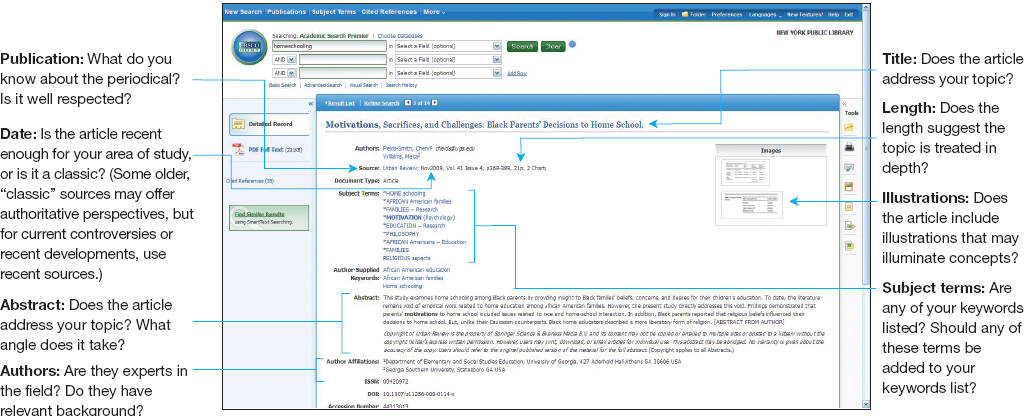Choosing Relevant Sources
Sources are relevant when they help you achieve your aims with your readers. Relevant sources may
- explain terms or concepts;
- provide background information;
- provide evidence in support of your claims;
- provide alternative viewpoints or interpretations;
- lend authority to your point of view.
A search for sources may reveal many seemingly relevant books and articles—more than any researcher could ever actually consult. A search on the term home schooling in one database, for example, got 1,172 hits. Obviously, a glance at all the hits to determine which are most relevant would take far too much time. To speed up the process, resources, such as library catalogs, databases, and search engines, provide tools to narrow the results. For example, in one popular all-purpose database, you can limit results by publication date, language, and publication or source type, among other options. (Check the Help screen to learn how to use these tools.) In this database, limiting the home schooling results to articles published in scholarly journals in English over the last ten years, reduced the number of hits to fifty-six, a far more reasonable number to review. (Remember that if you have too few results or your results are not targeted correctly, you can expand your search by removing limits selectively.)
Once you’ve reduced your search results to a manageable number, click on the remaining titles to look closely at each record. The analysis of an article’s detailed record in Figure 25.1 shows what to look for.
For more on focusing search results and selecting search terms, see Chapter 24.
After you have identified a reasonable number of relevant sources, examine the sources themselves:

- Read the preface, introduction, or conclusion of books, or the first or last few paragraphs of articles, to determine which aspect of the topic is addressed or which approach to the topic is taken. To obtain a clear picture of a topic, researchers need to consider sources that address different aspects of the topic or take different approaches.
- Look at the headings or references in articles, or the table of contents and index in books, to see how much of the content relates specifically to your topic.
- Consider the way the source is written: Sources written for general readers may be accessible but may not analyze the subject in depth. Extremely specialized works may be too technical. Poorly written sources may be unreliable. (See Choosing Reliable Sources, p. 692, for more on scholarly versus popular sources and for a discussion of why researchers should avoid sources that are poorly written or riddled with errors.)
If close scrutiny leaves you with too few sources—or too many sources from too few perspectives—conduct a search using additional or alternative keywords, or explore links to related articles, look at the references in a particularly useful article, or look for other sources by an author whose work you find useful.